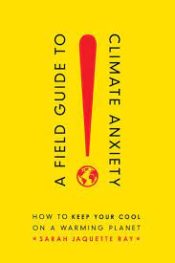Content written by Isa Swain, North Salem HS Regional Leader
 When taking action for the environment, we should not underestimate the importance of emotions – our own and each other’s. Reading A Field Guide to Climate Anxiety: How to Keep Your Cool on a Warming Planet by Sara Jaquette Ray helped me come to this conclusion and reflect on the impact of my work to involve my peers in climate action.
When taking action for the environment, we should not underestimate the importance of emotions – our own and each other’s. Reading A Field Guide to Climate Anxiety: How to Keep Your Cool on a Warming Planet by Sara Jaquette Ray helped me come to this conclusion and reflect on the impact of my work to involve my peers in climate action.
The main project that North Salem High School’s regional leaders and Environmental Club members worked on this year was implementing a system of commercial composting. This involved lots of planning and testing, but one thing that we wanted to do before we actually started collecting food waste from cafeterias was to engage, inspire, and motivate our peers to join in the process. After brainstorming various ideas, we decided on making a slide presentation, which we could send out to teachers to present in front of their classes.
Here’s the issue: at the time, I had a more limited perspective on the role emotions play in climate action. I didn’t consider the impact that our work has on the emotions of our community and how that affects their ability to contribute to incremental, systemic change. As a result, the presentation mainly conveyed the message that the only ways to reduce waste are on an individual consumer level. Filled with doomsday and carbon footprint narratives, it had the unintended effect of creating anxious, panicked, and guilty moods in the audience. These narratives are harmful, as they cause people to feel that they cannot make a difference or that being a part of climate action is not worth the toll on their mental health.
After reading A Field Guide to Climate Anxiety, I realized that the presentation had the opposite effect of engaging, inspiring, and motivating my peers. The book, which according to Ray helps the reader “figure out how to not just address but thrive in a climate-changed world” (pg. 17), explores how stories of urgency and doom can be replaced with stories of collective and societal transformation to give people the motivation and energy they need to do climate work for the long-haul. Ray also unravels the myths that climate work needs to be “spectacular moments of triumph” (pg. 54) and that an individual cannot make much of a difference. In addition, she describes how to prioritize connection over being right, and how to resist burnout, which are both essential to the climate movement. I learned that there is a strong relationship between narrative, emotion, and individual decision-making.
Ray states that the book helps answer the question, “What will it take—existentially—to engage in work towards climate justice for the long haul and not just react in fear and panic to today’s news of injustice and forecasts of apocalypse?” (pg. 17) I wholeheartedly agree. After reading the words of Sara Jaquette Ray, I’ve learned to reflect on my own work and how it has an impact on the emotions and actions of people in my community. The target audience of the book is “the climate generation” (a.k.a. Gen Z), climate activists, and anyone who feels powerless or anxious when thinking about the climate crisis. If you are a part of one of those groups, I would highly recommend you to check out A Field Guide to Climate Anxiety from your local library. I hope it can be a useful tool for you to envision and work towards a better future.
